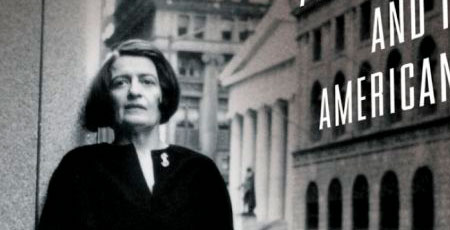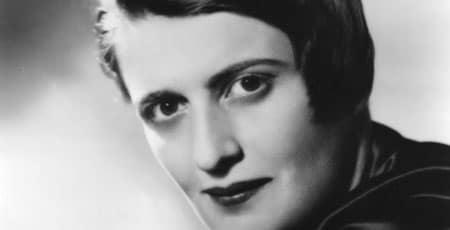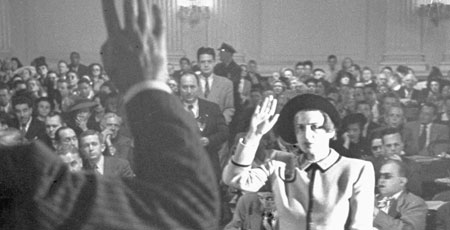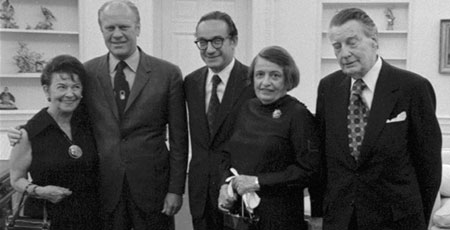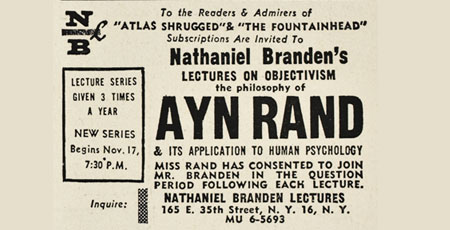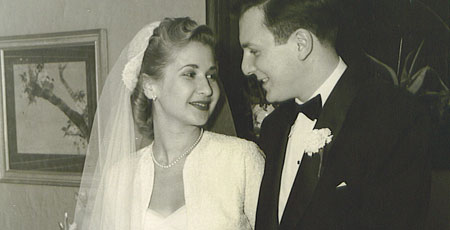
AYN RAND
THE RAND ARCHIVES
I was the first historian granted unfettered access to Ayn Rand’s cloistered private archive. Many readers of my book were curious about my research and the role of the Ayn Rand Institute in shaping Rand’s legacy. Below is a blog series written in response to reader queries. For a longer account, see my essay in Raritan Quarterly.
05 September 2009

Part 1: Gaining Access
The legacy of Ayn Rand is a source of never-ending controversy, which I seem to have stirred up again with my forthcoming book, Goddess of the Market: Ayn Rand and the American Right (Oxford University Press). Many observers are wondering: How did I get access to the Ayn Rand Archives?
Very simply: I asked....
read moreRather, since I was a graduate student at the time, my advisor inquired in a formal letter. This was back in the fall of 2001. I had written a research paper on Ayn Rand, but before I proceeded to design a dissertation about her, it was vital to know if I could work in the archives. For my project to make an important contribution to scholarship, I would have to go to the original sources generated by Rand herself. At the time, the archive was not officially open. But there was a newsletter, and I reasoned that if the archive published a newsletter, they must want visitors.
As it turned out, the archives were open, and willing to have me, with stipulations. The primary stipulation was that I not use the archival material to write a full length biography, since the Ayn Rand Institute had commissioned an Objectivist literary scholar, Shoshana Milgram, to write an authorized biography. Because my focus was on Rand in relationship to a particular aspect of American history – the American right – my work was classified as a “special study.” I was also told I would not be shown certain material related to legal disputes and a few items of sensitive nature pertaining to persons still living. Other than that, I had free rein in the archive. (Along the way, I did in fact stumble across some material I wasn’t supposed to see – more on that later).
So in the summer of 2003, all my qualifying exams behind me, I packed up my car and drove down to Irvine. It would be the first of many visits over the years.
13 September 2009

Part 2: The edited letters and diaries
Perhaps no part of Rand’s legacy is more controversial today than the editing of her letters and diaries. When the Estate of Ayn Rand released two huge volumes of her letters and diaries in 1995 and 1997, Rand fans were thrilled. It didn’t take long, however, for suspicions to surface. Sifting through ....
read more.. earlier published excerpts of Rand’s journals, NYU scholar Chris Sciabarra discovered that the journals had been edited. As I write in my forthcoming book, “After several years working in Rand’s personal papers I can confirm Sciabarra’s discovery: the published versions of Rand’s letters and diaries have been significantly edited in ways that drastically reduce their utility as historical sources.”
When I arrived at the Ayn Rand Archive, I kept quiet about all of this. I was a little bit paranoid, in fact, during my early time at the Archive. I had read all the stories about Rand infighting, the schisms, purges, and breaks. I knew it would take me years to finish my dissertation, and then write a book, and I didn’t want to jeopardize my access to the archive.
Then one day, I mentioned the books in passing, and an archivist rolled his eyes at me.
“Those were done years ago,” he said. I sensed an opening. “Yes, I noticed some discrepancies…” I began tentatively. The floodgates sprang wide. The staff at the archive knew all about the editing – and they heartily disapproved. The staff at the Ayn Rand Archives is professionally trained and serious about their work; like all archivists and librarians, they treasure knowledge for its own sake and scrupulously try to preserve the historical record.
I felt a great weight lifting from my shoulders. No longer would I have to pretend there was nothing problematic about the published letters and journals. I began a serious concordance project, doing line by line comparisons of the published text and the originals. It was tedious, eye straining work. The archivists helped me locate the right files, which had been scattered into many folders.
When two Objectivist scholars, funded by the Ayn Rand Institute, arrived at the archive, I was again circumspect. Then I heard loud sighs of disgust arising from a nearby scholar. He, too, was comparing the different versions, and he, too, was outraged.
26 September 2009

Part 3: Publishing
By the end of my research, I had been disabused of many assumptions I had made about the Ayn Rand Archive. Rather than some weird type of cultish organization, it was comparable to a typical university or government archive.
One question remained: would I be able to publish any of my research?....
read moreThe Ayn Rand Archive is distinct from the Estate of Ayn Rand. Like most archives, it serves as a depository of materials, but does not own copyright and cannot grant permission to publish. I knew by now the Archives staff was on my side. They had watched me work for more than eight years, and had seen me through graduate school, a book contract, getting married, starting my first academic position. They wanted to see my hard work pay off as much as I did.
Now we were down to the wire. My manuscript was due in a matter of weeks. It was now finalized to the point where I knew what I wanted to include. This in itself had been a tricky process. I had tried to write the manuscript so that if I were denied permissions to quote directly, I could do a quick rewrite. But in truth, I knew that a denial of permissions would have gutted the book.
The first step was to hand the manuscript over for review by an Objectivist scholar trusted by the Estate. The verdict was favorable. The reviewer disagreed with much of what I said, but recognized this was a serious book about Rand. The Estate indicated it would grant permission for all but two quotes, both involving Ayn Rand’s opinions about certain people close to her. This was from archival material I was not supposed to see, but had discovered in my diggings. Since neither quotation was pivotal to my central theme or arguments, I was happy to comply.
And then came the amazing day when I received a letter signed in the spidery handwriting of Leonard Peikoff, Rand’s intellectual heir.
25 September 2009

Part 4: What Will Happen Next?
The letter I received from Leonard Peikoff was a mere formality; he simply signed off on a standard request to publish specific unpublished material from the archives (a list of which stretched to more than 14 pages). The most notable thing about the letter was Peikoff’s fragile signature, which reminded me ....
read more.. the generation who knew Rand intimately is aging and that it won’t be long before we are left with only the written record. What the letter signified, however, was truly remarkable: for the first time, the Estate of Ayn Rand had granted publishing permissions to an outside scholar who had authored a full length, critical study of Rand. Why did the Estate grant me permission to publish? Though I will never know the answer for certain, I can offer some ideas. (Please note: I have not ever met or spoken to Leonard Peikoff, Rand’s literary heir and the custodian of her estate, and what I suggest here is my opinion, supplemented by information from those who do know him well). One reason was clearly the book itself, which had sufficient merit to warrant support. I also believe that more than twenty years after her death, Peikoff may have realized that being excessively protective of Rand’s legacy has damaged rather than helped her. This is certainly something I noticed at the outset of my project in 2001: though there were many books about Rand, most were written by friends or foes, with a noticeable lack of the kind of critical academic attention other contemporary novelists attract as a matter of course. Not a single scholar in my field, American intellectual history, had written a peer-reviewed article or book on Rand. For Peikoff, trusted by Rand to advance her legacy and like her a believer in the power of intellectuals, this situation must have been distressing. I also believe that granting me permission to publish flowed naturally from his earlier decision to establish the Ayn Rand Archives; after all, implicit in the establishment of a research center is that some of this research be published. Perhaps the more important question is: what does the publication of Goddess of the Market: Ayn Rand and the American Right mean for the future of Rand scholarship? Are the doors now wide open, and will we see a boom of new archival work on the life and legacy of Ayn Rand? Again, I can offer only tentative hypotheses and ideas. As I have written in this blog series, my experience in the archive was positive. Nor was the permissions process unusual. Several other heirs asked to see relevant portions of the intended work before granting permission to publish, and some even charged me for the privilege. It is worth, noting, however, that the archive’s access policies remain in transition. The Archive is currently undergoing a digitization process to preserve its holdings (to those conspiracy theorists out there: I’ve seen the cameras, and the work queue, and this project is indeed happening). This preservation project will logistically limit the numbers of scholars who can be accommodated. It is also possible, though I dearly hope not, that the publication of my book will trigger a backlash against any further openness. I do not believe this will occur. So what happens next? Here I will offer a few predictions (always risky for the historian!): 1.) I believe the archive will continue to offer access to scholars interested in Rand’s work, and by scholars I do not mean those exclusively associated with the Ayn Rand Institute, but persons enrolled in or working for a degree granting institution or those who can demonstrate, through the formulation of a cogent research proposal, that they have a serious intellectual interest in Rand. 2.) Scholars primarily interested in the personal or biographical aspects of Rand will encounter difficulties, at least until the publication of Shoshana Milgram Knapp’s authorized biography of Rand. Knapp, an English professor at Virginia Tech, is devoting significant time to this project. Though I do not know the details of her arrangement with the archive or the Estate, it is my understanding that authors working on projects which may compete or conflict with hers will not be given access to the Ayn Rand Archive (this is the reason Anne Heller was denied permission to view Rand’s papers.) The publication of Knapp’s book should be good news for the entire community interested in Rand. She is a serious scholar who does careful work, and she will likely produce a detailed and intelligent account of Rand’s life. Knapp has shared some of her preliminary findings with me, and I know they will arouse great interest. Her project was originally limited to the years prior to 1957, but may have developed since. 3.) The Estate’s tenderness around the personal aspects of Rand’s life leads me to predict it will be many years before there is a full and impartial outside account of the Rand-Branden affair. This is rather a shame, since I know from my research the Archive has ample holdings that would more than satisfy the widespread curiosity and controversy about their relationship and its ending. Both because of my agreement with the archive and since my interest in Rand was primarily intellectual, this material informs only a small portion of my manuscript. I hope and expect that within my lifetime, another writer will give this aspect of Rand’s life the attention it deserves. 4.) As for the published letters and diaries of Ayn Rand, that they have been edited is now widely known within the Objectivist community and is freely spoken of within the Ayn Rand Archives. I have heard some talk of a “scholar’s edition” of these materials, complete with footnotes and annotations. However, since recent work published by the Estate continues the practice of editing Rand’s words, I do not expect a revised edition anytime soon. However, to the extent the Archive remains open to outsiders, this problem can be surmounted. Rand’s legacy will thus exist on two levels: one for the general reading public, and one for the scholarly community.26 November 2009

Part 5: On the Brandens
I originally intended In the Rand Archive to be a four part blog series, but due popular demand I am now extending the series to cover a number of topics readers have asked about. In this installment, I discuss my findings in the archive that relate to Rand’s relationship with Barbara and Nathaniel Branden. ....
read moreLet me say at the outset of this posting that I do not consider Rand’s relationship with Nathaniel Branden to be the foundational event in her intellectual or emotional life; I think the influence of Isabel Paterson and Frank O’Connor has been overlooked in the general focus on Nathaniel Branden. Nor do I think Rand’s extramarital affair with Branden is particularly noteworthy. Part of the fascination with this episode comes, I believe, from our own embedded expectations about gender and sexuality. Would anyone consider it remarkable or unusual for a famous and wealthy male author in his 50s to convince a young acolyte into a sexual affair? “Open” relationships and non-traditional marital arrangements are also par for the course when it comes to intellectuals, even American ones – examples can be found in the ideas of “free love” in New York’s Greenwich Village, the career of Victoria Woodhull, and the Brook Farm community in the 19th century.
Nevertheless, there is clearly a burning curiosity – and controversy – over all aspects of Rand’s relationship with Nathaniel and Barbara Branden. Many readers have wondered what, if anything, I saw in the archives that speaks to these controversies. So here I will briefly sketch out some of my findings on this matter.
When I began researching, my primary understanding of Rand’s life came from the two Branden memoirs, Barbara Branden’s The Passion of Ayn Rand and Nathaniel Branden’s Judgement Day: My Years with Ayn Rand. In my first stage of research, one of my primary goals was simply verifying if the essentials of the Brandens’ stories were correct. I was surprised to discover how accurate both books were. I did not discover any major errors or distortions in basic chronology or timing. I viewed the first series of correspondence between Rand and Nathan Blumenthal, and Barbara Weidman’s letters to Rand when she was away from her (the two later changed their names to Barbara and Nathaniel Branden). All of this material matched the accounts in the memoirs: here was the story of early difficulties in the relationship between Barbara and Nathan, for the reasons described; Nathan’s turbulent relationship with his family; the inflammatory letter he wrote to the UCLA newspaper (which I quote in my book), and so forth.
I also spent a good deal of time trying to discern what, if anything, Rand told Nathan Blumenthal about “free will.” This topic surfaced in their first letters and was one reason Rand decided to contact Blumenthal. Additionally, some of Murray Rothbard’s surviving letters indicate she changed her mind about this concept during the 1950s (for details, see Justin Raimondo’s An Enemy of the State: The Life of Murray Rothbard). I could not uncover anything to speak to this point one way or the other, and so let it lie. Here, my guiding philosophy was that unless something I found contradicted the Brandens’ memoirs, it would not be a focus of my published work. Though my interest in Rand was primarily intellectual, rather than on the personal nature of all her relationships, part of my job as a historian is to set the record straight and I would have done so had I felt the Brandens were untruthful in their description of Rand or their relationship with her.
That said, there were several aspects of Barbara Branden’s memoir which material in the archive definitely falsifies: the most famous of these is the typewriter story. Material from the archive indicates this legend is long established in family history and originated with Rand herself, though it is unclear if the youthful Rand was experimenting with tales of origin, or if the distortions of memory played a role (think of a game of telephone, stretched across generations). Barbara Branden also describes Leo as the young Rand’s primary love interest, while letters from the Rosenbaums indicate Rand had a devoted male admirer, “Seriozha”, who was a fixture in their household and accompanied Rand as far as Moscow when she was leaving Russia. So perhaps that famous fib about a fiancé which got her out of Latvia had more truth to it than previously understood. In both cases, these errors are explainable and even predictable, given that Barbara Branden’s account was based upon oral history and Rand’s own memories about herself at a young age, which are naturally selective and subjective.
In the next phase of my research, I began understanding, as I write in Goddess of the Market’s concluding Essay on Sources, “the subtle interpretative power” the two memoirs exert. I have touched upon these points in my book, but primarily they are: downplaying Rand’s continued connection to her family while in the United States; the significance of her relationship to Frank; the nature of her relationship to Leonard Peikoff. Here is some of the evidence I saw that led to my conclusions:
- Extensive letters from the Rosenbaums to Rand during the 1920s, including correspondence about her failed effort to bring them to the United States in 1937.
- Stacks of notes between Ayn and Frank, signed with obvious affection. Ayn often left these for Frank when she stayed up late to write. They emphasized for me how pivotal he was to her daily life, and how dependent she was upon his presence and caring.
- Multiple interviews that suggested despite the dominant position Rand appeared to hold in the relationship, Frank had his own subtle power over her. As anyone who has read Hegel knows, even the relationship between master and slave (which their marriage assuredly was not) is far from clear cut.
- Biographical interviews where Rand stressed the importance of several conversations with Peikoff that helped her understand herself as a philosopher and convinced her to pursue that aspect of her thought more thoroughly. These segments of the conversation do not appear in the Branden’s memoir.
Overall, what I saw in the archive confirmed for me that while the Branden’s memoirs are useful sources, they should not be taken as the final word on Rand’s life.
21 February 2010

Part 6: On the Brandens (continued)
In my last posting, I discussed a few minor inaccuracies I discovered in Barbara Branden’s memoir The Passion of Ayn Rand. Did I find any inaccuracies in Nathaniel Branden’s memoir Judgement Day: My Years with Ayn Rand (later revised and republished as My Years with Ayn Rand)?
This question in itself is a difficult one to answer, ....
read moreas a memoir is by its nature subjective and personal. I did discover material that corroborated several aspects of Branden’s narrative – changes in his personality after he met Rand, the circumstances surrounding his move from Los Angeles to New York, his early relationship with Barbara. The paper trail largely vanishes when all three moved to New York. However, there is plenty of material in the archive documenting the repressive atmosphere that developed at New York NBI during the 1960s. New York NBI is also described in great detail by a number of published and unpublished sources that are not held in the Archive. Again, Branden’s memoir covers all this territory and he is quite frank in describing his role.
I did not discover any evidence that suggested his memoir was deliberately fabricated or untrue. Working in the archive did, however, help me recapture the perspective of Rand. By his own testimony, Nathaniel Branden acted poorly towards Rand, but because the story is told from his point of view in his two memoirs, it can be easy to lose sight of this truth.
But what of the affair and the aftermath? Did I see Rand’s notes on the ending of the affair? Are these available to researchers?
I did see some of Rand’s notes she kept as the affair with Branden unraveled. Rand’s writing was normally done on loose sheets of paper, so to my recollection there is not an isolated notebook where all this material is kept. I skimmed enough of this material to confirm Rand’s emotional devastation during this time. But I did not do a thorough investigation of this material, for several reasons. One was that I simply didn’t have the stomach to read the aftermath of another person’s love affair gone bad. Moreover, a detailed and lengthy accounting of Rand’s reaction to the affair did not fit with my own intellectual interests and the plan of my book. I saw enough to confirm that Rand was devastated by the end of the affair, that she struggled to understand it within the frame of Objectivism, and that she felt deeply betrayed and hurt by Branden.
Finally, given that my agreement with the archive stipulated that I refrain from writing a “full” biography, I suspected -- rightly it turns out -- that the Estate of Ayn Rand would not allow me to publish this material. Though I did not include material from these diary entries in my final manuscript, I did include quotations from similar material. These were the two items that the Estate requested I remove from the manuscript before granting me permission to publish everything else:
1. Notes between Rand and Nathaniel Branden on Objectivist psychological theories as applied to the Collective. This material corroborated Branden’s discussion of Objectivist psychology and the atmosphere at NBI. The Archive explained that permission was denied because these notes referred explicitly to still living persons. Interested parties can see edited versions of this material on pages 670-673 of The Journals of Ayn Rand.
2. Notes written by Rand in 1968 about Frank O’Connor and their marriage. I particularly regretted that I was not able to publish this material, for they were a fascinating window into Rand’s changing attitudes about Frank and her rediscovery of his virtues as her relationship with Nathaniel Branden crumbled. Some of their essence can be found in Rand’s introduction to the Twenty-Fifth Anniversary edition of The Fountainhead, published around the same time.
In summary, I do not believe there is a “smoking gun” in the archive that will transform our understanding of the Rand-Branden affair. Working in the archive can help recover Rand’s perspective on these events, as can be seen in the account of James Valliant, who uses archival material to build a prosecutorial brief against the Brandens in The Passion of Ayn Rand's Critics.
The opening of the archive means that the Branden memoirs no longer have to serve as the main source of information about Rand and her life. Instead, they can be appreciated for what they are: gripping first-hand accounts of two individuals who shared Rand’s life at the height of her public career.


